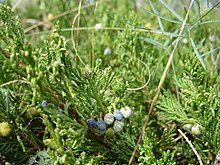Juniperus horizontalis,thecreeping juniperorcreeping cedar,[4]is a low-growingshrubbyjunipernative to northernNorth America,throughout most ofCanadafromYukoneast toNewfoundland,and in some of the northernUnited States.
| Juniperus horizontalis | |
|---|---|

| |
| Foliage and cones | |
| Scientific classification | |
| Kingdom: | Plantae |
| Clade: | Tracheophytes |
| Clade: | Gymnospermae |
| Division: | Pinophyta |
| Class: | Pinopsida |
| Order: | Cupressales |
| Family: | Cupressaceae |
| Genus: | Juniperus |
| Species: | J. horizontalis
|
| Binomial name | |
| Juniperus horizontalis Moench1794
| |

| |
| Natural range ofJuniperus horizontalis | |
| Synonyms[3] | |
Description
editLiving up to both its scientific and common names, the species reaches only10–30 centimetres (3+7⁄8–11+3⁄4in) tall but often spreading several metres wide. The shoots are slender,0.7–1.2 millimetres (1⁄32–1⁄16in) diameter. Theleavesare arranged in opposite decussate pairs, or occasionally in whorls of three; the adult leaf blades are scale-like, 1–2 mm long (to 8 mm on lead shoots) and1–1.5 mm (1⁄32–1⁄16in) broad, and derive from an adnatepetiole.The juvenile leaves (on young seedlings only) are needle-like,5–10 mm (3⁄16–3⁄8in) long. Theconesare berry-like, globose to bilobed,5–7 mm (3⁄16–9⁄32in) in diameter, dark blue with a pale blue-white waxy bloom, and contain twoseeds(rarely one or three); they usually have a curved stem and are mature in about 18 months. The male cones are2–4 mm (3⁄32–5⁄32in) long, and shed their pollen in early spring. It isdioecious,producing cones of only one sex on each plant.
It is closely related toJuniperus virginiana,and oftenhybridizeswith it where their ranges meet in southernCanada.Hybrids withJuniperus scopulorumalso occur.
Distribution and habitat
editThe species is native to northernNorth America,throughout most of Canada fromYukoneast toNewfoundland,and in theUnited StatesinAlaska,and continentally fromMontanaeast toMaine,reaching its furthest south inWyomingand northernIllinois.Amongst the sites it occupies are rocky areas of the east slopes of theRocky Mountains.[5]
Cultivation and uses
editWell over 100 differentcultivarshave been selected for use asornamental plantsin gardens, their strictly prostrate growth habit being valued for ground cover. Popular examples include 'Bar Harbor', 'Blue Acres', 'Emerald Spreader', 'Green Acres', and 'Wiltonii' ( "Blue Rug Juniper" ). Many of the most popular cultivars have strikingly glaucous foliage, while others are bright green, yellowish or variegated.
Gallery
edit-
Plant atPancake Baysand dunes,Ontario,Canada
-
Juniperus horizontalis'Wiltonii' as a garden plant
References
edit- ^Farjon, A. (2013)."Juniperus horizontalis".IUCN Red List of Threatened Species.2013:e.T42237A2965318.doi:10.2305/IUCN.UK.2013-1.RLTS.T42237A2965318.en.Retrieved13 November2021.
- ^NatureServe (2024)."Juniperus horizontalis".Arlington, Virginia.Retrieved18 August2024.
- ^Juniperus horizontalisThe Plant List (2010). Version 1. Published on the Internet;http:// theplantlist.org/22 Nov. 2011
- ^Bailey, L.H.; Bailey, E.Z.; the staff of the Liberty Hyde Bailey Hortorium. 1976.Hortus third: A concise dictionary of plants cultivated in the United States and Canada.Macmillan, New York.
- ^Arno, Stephen F.; Hammerly, Ramona P. (2020) [1977].Northwest Trees: Identifying & Understanding the Region's Native Trees(field guide ed.). Seattle:Mountaineers Books.p. 174.ISBN978-1-68051-329-5.OCLC1141235469.
Further reading
edit- Adams, R. P. (2004). Junipers of the World: The genus Juniperus. Trafford PublishingISBN1-4120-4250-X
External links
edit- USDA Plants Profile forJuniperus horizontalis(creeping juniper)
- Gymnosperm Database:Juniperus horizontalisArchived2006-04-30 at theWayback Machine
- Flora of North America:Juniperus horizontalis
- Plantmaps: Interactive Distribution Map ofJuniperus horizontalisArchived2017-03-19 at theWayback Machine
- Lady Bird Johnson Wildflower Center, NPIN Database:Juniperus horizontalis(Creeping juniper, Creeping savin)

